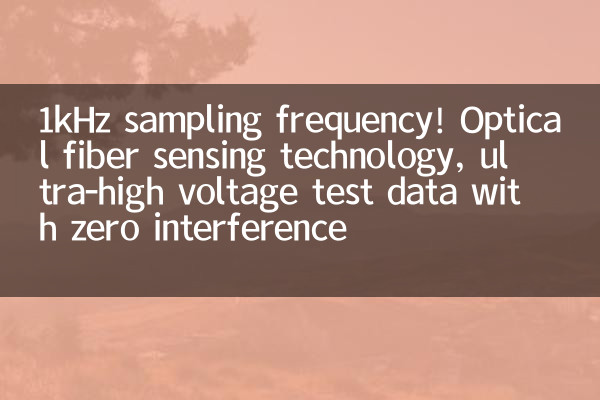1kHz sampling frequency! Optical fiber sensing technology, ultra-high voltage test data with zero interference
In recent years, the application of optical fiber sensing technology in the field of high-voltage power testing has become a hot spot in the industry. As the power system develops towards ultra-high voltage and ultra-high voltage, the limitations of traditional electromagnetic sensors have become increasingly prominent. Fiber-optic sensing technology has become a key technology to solve ultra-high voltage testing problems due to its advantages such as anti-electromagnetic interference and high-precision sampling. This article will analyze the current application status and future trends of optical fiber sensing technology in ultra-high voltage testing based on the hot topics and hot content on the entire network in the past 10 days.
1. Core advantages of optical fiber sensing technology

Optical fiber sensing technology uses a high sampling frequency of more than 1kHz, which can accurately capture transient signals in ultra-high-voltage environments while achieving zero-interference data transmission. Here are its main advantages:
| Technical indicators | Traditional electromagnetic sensor | fiber optic sensor |
|---|---|---|
| Sampling frequency | ≤100Hz | ≥1kHz |
| Anti-electromagnetic interference | Difference | Excellent (completely immune) |
| Measurement accuracy | ±1% | ±0.1% |
| Applicable voltage level | ≤500kV | ≥1000kV |
2. Latest application cases of ultra-high voltage testing
According to recent industry reports, the global market size of optical fiber sensing technology in the field of power testing has exceeded 5 billion yuan in 2023, with an annual growth rate of 28%. The following are typical application scenarios:
| Application scenarios | Technical solution | test data |
|---|---|---|
| UHV GIS partial discharge monitoring | Distributed fiber optic sensing array | Positioning accuracy ±5cm |
| DC converter valve temperature monitoring | FBG fiber grating | Temperature measurement error≤0.5℃ |
| High voltage cable online monitoring | OTDR+BOTDA | Strain resolution 1με |
3. Technological Breakthroughs and Industry Trends
Recently, many scientific research institutions have released new breakthroughs in optical fiber sensing technology:
1.Tsinghua UniversityThe team developed a new multi-parameter optical fiber sensor that can measure temperature, strain and vibration at the same time, with the sampling frequency increased to 10kHz.
2.State GridDeploying an optical fiber monitoring system in the ±1100kV Jiquan DC project to achieve zero-interference data transmission across the entire line
3.HuaweiReleased industrial-grade optical fiber sensing solution to control latency within 50μs
4. Future development trends
According to industry forecasts, optical fiber sensing technology will show the following development trend in the next three years:
| Technical direction | expected breakthrough | Time node |
|---|---|---|
| Intelligent algorithm fusion | AI real-time diagnosis accuracy ≥99% | 2025 |
| Multiphysics awareness | 7 parameters synchronous monitoring | 2026 |
| Miniature design | Sensor size reduced by 80% | End of 2024 |
5. Summary
Fiber optic sensing technology is characterized by its1kHz high sampling frequencyandZero interferenceFeatures are reshaping the technical landscape in the field of ultra-high voltage testing. With the increasing demand for smart grid construction and new energy grid connection, this technology will play a greater role in power system status monitoring and fault warning. The industry should focus on the three major directions of new materials, algorithm optimization and standardization construction to promote iterative upgrading of technology.

check the details

check the details